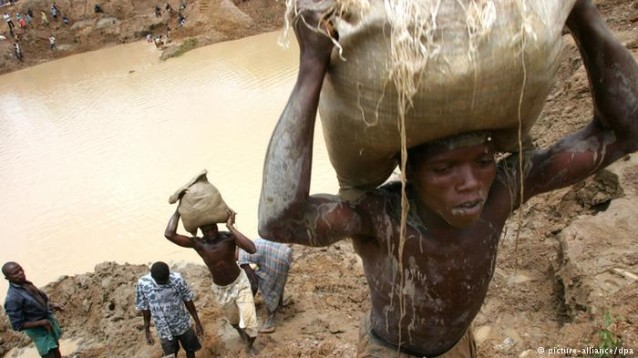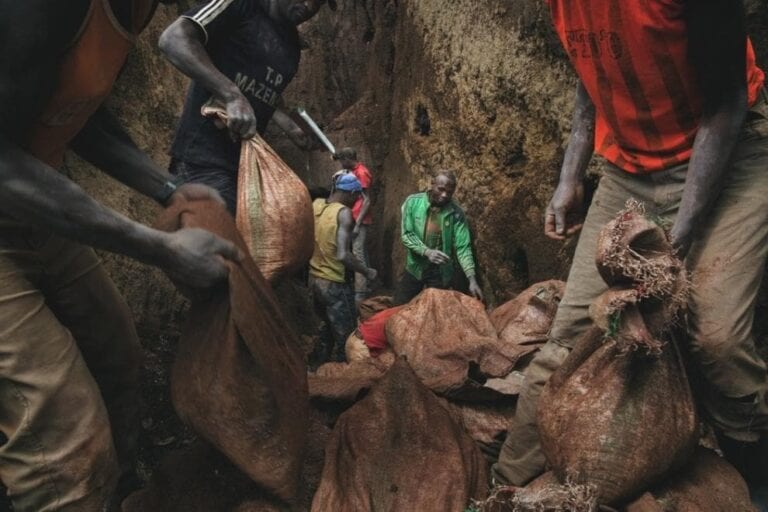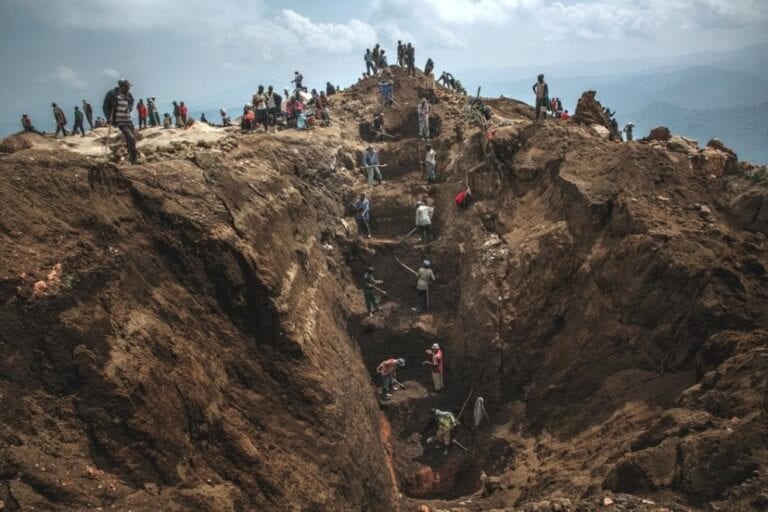RDC, the hell of the coltan and cobalt mines
The war for the resources of the Democratic Republic of Congo has never known a real truce. The country is rich in coltan and cobalt, highly sought after in international trade. Necessity has prompted indiscriminate exploitation by international companies. He is the one who pays the price, Once again, the Congolese population. Women and children are employed to extract these resources, forced to work in the mines for very low wages at exhausting hours
of Fiorella Spizzuoco and Ornella Ordituro
Coltan with a high tantalite content is the most precious in the world. Its use optimizes power consumption in next-generation chips, allowing considerable savings in electronic devices. More than half of the world's supply is mined in the southern part of the Democratic Republic of Congo (RdC).
In the last few years, the demand for Congolese cobalt has also increased due to the growth in the production of electric vehicles, a green but not sufficiently ethical solution. Its value is mainly due to the high sales demands in Asia, Europe and the United States. Artisanal miners, i diggers nella RdC, working alongside much larger industrial operations, they extract such minerals by hand using the most basic tools to dig rocks in deep underground tunnels. Since the covid pandemic has stopped schools, the borders are closed and there is a shortage of food, many children returned to the mines to mine and wash them.
The Democratic Republic of Congo
The Democratic Republic of Congo (RdC) it is a country that extends into the heart of Africa, a land full of contradictions, plagued by internal conflicts that make the life of the local inhabitants a real hell, along with poverty, to the risks linked to climate change but also refuge for other populations in the region. According to UNHCR data, currently the DRC is the second largest country in the world, after Syria, by number of internally displaced persons; welcomes half a million refugees fleeing conflict, often caused by militia violence, in other areas of the region. In the last months, the death of the Italian ambassadorLuca Attanasioand the Carabiniere Vittorio Iacovacci, in an attack on a United Nations convoy near Goma, brought the reality of Congo to the attention of European public opinion. It is a complex puzzle made up of armed groups, corruption and foreign interests that make Congo a "land without peace".It is mainly the natural resources present underground that fuel conflicts and problems.
I territory of the Congo, especially those in the eastern part, they are rich in minerals such as cobalt, copper and uranium. Gold is also present in large quantities in the South Kivu and Ituri regions; but it is above all coltan that attracts the attention of international buyers. Present in large quantities in the North Kivu region, coltan is essential for the production of batteries and technological tools such as cell phones, tablet e computer. North Kivu is the area where the attack on the convoy in which Attanasio was traveling took place, theater of continuous clashes and attacks precisely due to the concentration of coltan in its mines. Even in Congo, the so-called “resource curse” hits hard: as in the rest of Africa, independence from Belgium in 1960 marked the beginning of strong tensions.
From Belgian Congo to Zaire
After 1960, year in which it formally obtained independence from Belgium, the RdC has gone through hard years of internal conflicts. Fragmented and weakened, it was the subject of contention between different factions who aspired to political control over this territory rich in natural resources and deposits of precious metals. In 1967, after a period of instability and a coup, the head of the army took powerSese Seko explodes, a charismatic and authoritarian figure who approved a new constitution and the change of the name from the former Belgian Congo to Zaire. Years of dictatorial rule began, ended in blood by a new civil war, which coincided with the exodus of thousands of Hutu refugees in refugee camps in Zaire who were fleeing the explosion ofethnic hatred between Hutu and Tutsi in neighboring Rwanda. Internal tensions, added to the external pressure, they brought in 1997 to a new coup d'état by the Alliance of Democratic Forces for the Liberation of Zaire(born from the union of the forces opposing Mobutu) portLaurent Desire Kabila in power.
However, Congolese history experienced an even bloodier period, that is, what goes from 1998 al 2003, when a second civil war took place which crossed national borders to spread to various neighboring states. The two factions that confronted each other in that conflict were respectively led bygovernment of Kinshasa and fromRwandan Patriotic Front (RPF), and they clashed for reasons very different from those of an ethnic or political nature. The opposing forces took to the field to compete for supremacy over theresources of the Congo territory, starting an unscrupulous war that caused the death and suffering of thousands of defenseless civilians. It was precisely the aforementioned eastern area of the country that was disputed, with its coltan deposits accumulated along the banks of the Congo river and in various points underground.
Coltan and international interests
Sinking its roots in the very first years that followed independence from the rule of Belgium, the war for the resources of the DRC has never known a real truce. Coltan is a material in high demand in international trade: it is a mixture of columbite etantalite and from its processing tantalum is obtained, a metal powder very resistant to heat, capable of withstanding a high electrical charge. With technological progress and the increase in demand for electronic devices for everyday use, The price of coltan also increased exponentially, and so is the interest of illegal traders, who recognized the potential profit from the irregular extraction and sale of the mineral.
The international interest and poor regulation of the coltan extraction and production chain meant that it earned the nickname "bloody resource" already in the 1990s., hand in hand with the widespread diffusion of new everyday technologies that are assembled in China, in Europe or the United States. The need to satisfy demands has prompted indiscriminate exploitation by international companies, but it also favored the inclusion of various armed groups in the control of extraction processes, who use the proceeds to purchase weapons useful for clashes for control of the territory. He is the one who pays the price, Once again, the Congolese population, grappling not only with civil conflict but also with poverty and unemployment. These factors favor both international companies and local coltan traders, that they employ above allwomen and children in the mines, where they are forced to work for very low wages at exhausting hours. Children's small hands are particularly suited to mining minerals, as well as their stature, since the mines are made up of narrow tunnels that a man of normal height would not enter.
Children's hands
The second largest country on the African continent has 85 millions of inhabitants, of which the 56% they are minor. Despite the richness of its natural resources and its potential economic development, the DRC remains one of the poorest countries in the world. Around 80% of Congolese boys and girls do not enjoy childhood rights, they mainly mine cobalt, mainly intended for China, in particularly dangerous conditions and wash the rocks immersed in polluted pools. The 20% of the mineral extracted comes from the southern part of the country, where the coronavirus brought the children of Kolwezi back to the mines, the world capital of rare earths.
In the communities of Domaine Marial, the 65% of children among them 8 e i 12 years he works in the mines; in the Kanina area almost the majority of school age people do it. Sometimes, these are also children in an age range between 6 they 8 years, which are particularly suitable for insinuating themselves into narrow tunnels for the extraction of minerals. They work in extreme conditions, for more than twelve hours, without any protection and with wages equal todue $ per day. The risk of getting sick earlier and more than their peers is very high, as well as accidents, even mortals, at work due to carrying too heavy loads or due to cave collapses in the former province of Katanga. Children are, furthermore, subject to greater abuse and abuse, often brutally mistreated by corporals and security guards.
The exploitation of child labor is prohibited by numerous international conventions (the Universal Declaration of Human Rights; the International Convention on the Rights of the Child; Convention 138 of the ILO; Convention 182 of the ILO; the Declaration of the International Labor Organization on Fundamental Principles and Rights at Work), However, many local minors work out of economic necessity even after having attended a few years of school, others have never had access to primary education. This is mainly due to the lack of adequate funding from the state, as most schools do not cover the cost of education, like teachers' salaries, uniforms and teaching materials.
Government intervention
In the last few years, there was no shortage of initiatives from the miners' families who, with the help of numerous civil society organizations, – overwhelmed by the work of sifting and washing the cobalt without masks or gloves, exposed to a high risk of respiratory diseases and serious infections – have denounced the difficult context in which they work, asking governments, financial institutions, international organizations and the private sector to take action to support artisanal mining communities and, above all, put an end to child exploitation in mines. At the risk of becoming seriously ill or dying, which is high for everyone, the general safety conditions are added, whose precariousness depends on the context of the country: the militias can take control of the mines at any time. In the end, the race to the bottom of mineral prices exposes workers, of any age, to exploitation.
In 2016, the RdC government has, therefore, created a Commission on child labor in the mining sector and drew up a strategic plan with the aim of no longer having minors employed in artisanal mines by 2025. The companieselectronics multinationals and automotive factories must ensure that the cobalt used in their products has not been extracted from the exploitation of child labor; they have the responsibility to identify, to prevent, resolve and account for human rights abuses across their supply chain and making human rights risk assessments available remains key.
Cobalt is important to the local and national economies of the DRC, nevertheless, the sector faces major challenges in translating this mineral wealth into sustainable development outcomes and an equitable distribution of productivity gains.
About that, from the end of 2020, The National Ministry of Mines of the RdC, represented by Willy Kitobo Samsoni, has been added to the Cobalt Action Partnership Steering Committee (CAP), demonstrating the government's presence in the sector.
The cap, an initiative in collaboration with the Global Battery Alliance – a collaboration platform founded in 2017 by the World Economic Forum to establish an ethical sustainable battery value chain by 2030 –, was formalized in May 2020 as a coalition of public and private organizations united for the sustainable and ethical mining of cobalt.
The interested parties, who implement the Partnership, are committed to identifying solutions and actions in the private sectors, public and non-profit in order to regulate the extraction and sale of artisanal and mining cobalt, promote global market access for manufacturers, formalize operations, eradicate child labor and human rights abuses in cobalt mining communities, as well as harmonize existing initiatives working on these issues both to achieve the objectives of the Paris Agreement and economic development in line with the United Nations idea of environmental sustainability by 2030 and to protect human rights.


